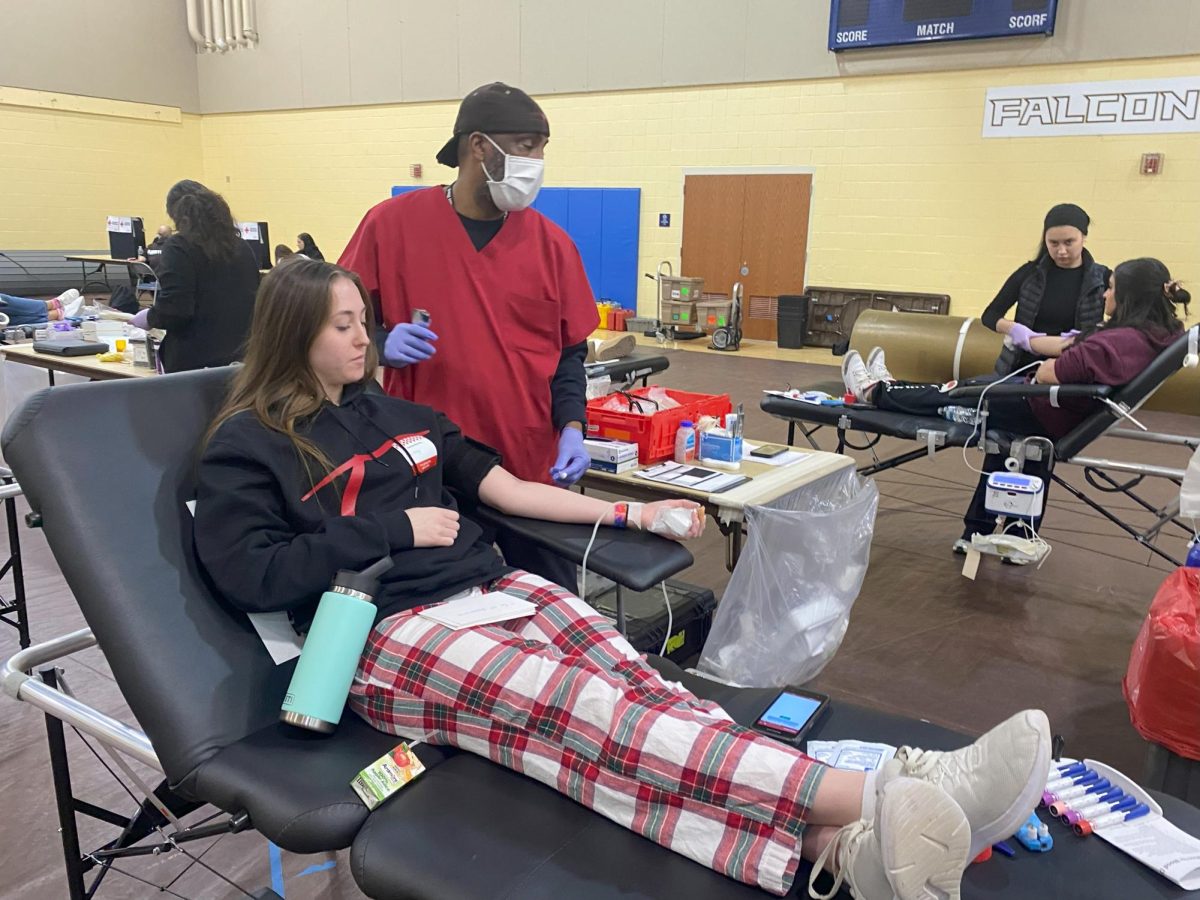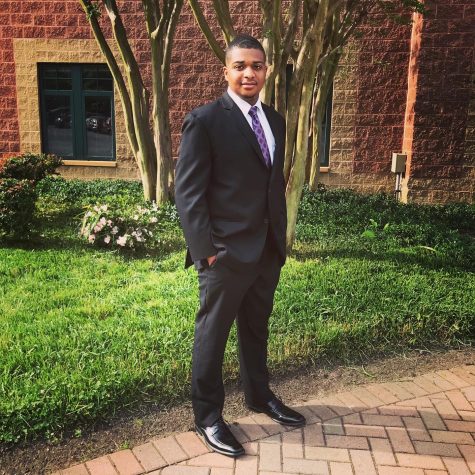Good Counsel’s blood drive occurred on Tuesday, February 13, 2024, in the Litton gym. Three Good Counsel students who donated blood, Kiley McEnerney ’25, Rania Saleem ’24, and Lauren O’Hara ’24, were interviewed. Ms. Corey Shore, a parent volunteer, and Mr. David Hall, with Red Cross Donor Recruitment, also sat for interviews.
First, students Kiley McEnerney ’25 and Rania Saleem ’24, who were sitting at the recovery tables after giving blood, were interviewed.
Kiley McEnerney ’25
P: What drove you to give blood?
K: I’m part of the LLS, which is the Leukemia Lymphoma Society, and I just felt like I needed to help towards cancer and giving people blood, people who need it, like our older population.
P: Do people you know give blood?
K: Some of my friends, not too many.
P: Did you have to get your blood tested?
K: I did have to get my blood tested for iron.
P: Anything about blood type? Do they test for that?
K: They did not tell me my blood type.
P: Describe the experience from beginning to end.
K: First, they tested to see if I had a vein big enough to stick a needle in it, and then they squeezed something to make sure the vein was there. They stuck the needle in, and then they drew a pint of blood. I did feel a little nauseous, so they did have to lay me back and put some cold things on me. Then afterward, they unclipped me, wrapped my arm, and put a Red Cross on my arm to secure the blood.
Rania Saleem ’24
P: What drove you to give blood?
R: My dad donates, and I think it’s a very helpful thing to do.
P: Are there any other people you know who give blood?
R: My dad and my older brother.
P: Do you have to get your blood tested?
R: Yeah, I got it tested for iron last year.
P: What is the best part of the experience?
R: The Chick-fil-A was a nice touch!
P: Could you summarize your experience here, from beginning to end?
R: It was very efficient, and it was an easy process. I didn’t think it was going to be hard, but it wasn’t too bad, like painful or anything. And everybody was really nice.
P: So you wouldn’t say that it took a lot out of you?
R: Not too much, no.
Next, Ms. Corey Shone, a parent volunteer, was interviewed.
Ms. Corey Shore, GC Parent
P: What inspired you to volunteer today?
Ms. S: Well, my daughter’s a part of Falcons Serve Others, so I just was willing to help however I could.
P: Were there any people you knew here, any students or adults you knew today that give blood here or elsewhere?
Ms. S: Actually, no, nobody that I knew was giving blood today, no.
P: When students come here to get their blood drawn, do they have to get tested, and for what?
Ms. S: I don’t know the answer to that question.
P: Okay, that’s fine. What is your favorite part about volunteering?
Ms. S: Just enjoy getting to know more people and just to be helpful.
P: Could you describe the process of drawing blood from beginning to end?
Mrs. S: So, I’ve just been observing, but it seems like everything’s going pretty well, and people aren’t having to wait too long. But they just register and check in, and then they have some health questions that they get answered, and then they donate the blood, and then they come to the recovery area for twenty minutes just to be sure they’re feeling okay.
P: What is your role in the volunteering here today?
Ms. S: Just here to help Ms. Hanson and Falcons Serve Others.
P: What is Ms. Hanson’s role in the process?
Ms. S: She’s in charge of the drive.
Next came the third recovering student blood donor, Lauren O’Hara ’24.
Lauren O’Hara ’24
P: What drove you to give blood?
L: I wanted to help others because there is a shortage, and I wanted service hours.
P: What service hours do you get for this?
L: You get two hours.
P: Do people you know give blood?
L: Yeah.
P: Do you have to get your blood tested for anything?
L: They have to check the hemoglobin first, and then they take extra blood to check for diseases.
P: What is the best part of the experience for you?
L: The food after.
P: Right; okay. Could you quickly summarize the experience?
L: It was pretty quick; everyone was efficient, and everyone was nice. It was good.
The final interview with Mr. David Hall, Red Cross Donor Recruitment, was the most edifying.
Mr. David Hall, Red Cross Donor Recruitment
P: What is your involvement in the blood drive today?
Mr. H: I work in Donor Recruitment. So, basically, I’m the one that will do the outreach to the schools and the community groups and try to ask them to pledge to donate blood. So, I make all those arrangements and get that settled.
P: Would you say that you are in charge of the operation today?
Mr. H: No; actually, the collections team’s in charge of the operation today. I just help where I can on the Donor Recruitment side, just to make sure everybody has a good experience as best as I can.
P: What trends have you seen: is there a particular demographic that usually donates? Within the school?
Mr. H: So, only about three percent of the population donates, so it’s a very small population. Our donor base tends to be an older donor base. I think COVID really hurt us in the sense that we weren’t doing drives at school, so now we’re trying to reintroduce them to the high schools and the colleges because we need that younger donor base. The schools make up between ten and twenty percent of our collection, so they’re vital to helping save lives.
P: So, due to this COVID decrease, and even before, was there a blood shortage?
Mr. H: It’s generally seasonal, so usually, in the wintertime, we tend to collect fewer donations due to weather, cold, and flu season. We experience the same problem usually in the summer; a lot of people go away on vacation and aren’t around. So, those are two times of the year when we generally have a greater need.
P: Did the COVID crisis generally cause a shortage?
Mr. H: No, actually, more people came out during COVID. I think they were all cooped up inside and wanted to do something to help people, and this was one thing that they could do.
P: Do people need to give blood now, in modern times?
Mr. H: There’s always a need. Our region collects probably around eleven thousand pints per month. So that covers the Baltimore-Washington area. So, that need is constant; every two to three seconds, someone is in need of blood transfusion. Cancer patients, surgeries, trauma victims, premature babies, mothers in delivery that may have issues. So, there is a constant need, and we have to make sure that the product’s on the shelves when it’s needed.
P: What would you say is the most fulfilling part of the experience for you?
Mr. H: Just knowing that you have the potential to help up to three people with each donation. You won’t know the name of that person that received that blood, but we do send notices out that tell you which hospital received your unit. So, it’s a rewarding thing to know that you are helping people that need, and you’re not only helping the individual; you’re helping their family too. And we had that incident a few years back with the Good Counsel father that was hit by the truck and needed twenty-four units of blood. Thank goodness Suburban Hospital and Walter Reed, they had the blood products there to save him.
P: Would you say that you had a good turnout today?
Mr. H: Yes, it’s good. The students here at Good Counsel always come out and support us. Both of my kids graduated from here as well too, so I have a connection to the school. It’s a good school, and people are very supportive of the community needs.
P: Hopefully, you’ll be featured in the newspaper.
Mr. H: All right; I appreciate it! Thank you.
It appears that the GC Blood Drive 2024 was another success. Thank you to all who gave and volunteered.



